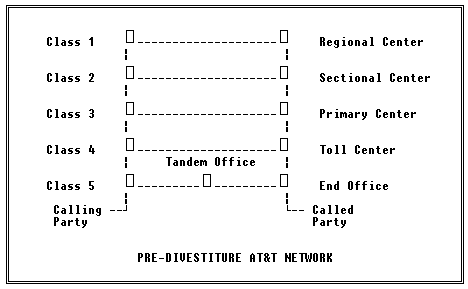| Voice Networking | Voice Networking |
The US Public Switched Telephone Network
The following subsections describe the basic organization and network design concepts implemented within the U.S. PSTN.
Organization
On January 1, 1984, ATT divested itself of its 22 Bell System operating companies based upon a 7 year antitrust suit filed against AT&T by the U.S. Department of Justice, and an agreed upon settlement. Ultimately, the Bell Operating Companies (“BOC”s) were grouped together into seven Regional Bell Operating Companies (“RBOC”s):
- Ameritech Corporation
- Bell Atlantic Corporation
- Bell South Corporation
- Nynex Corporation
- Pacific Telesis Group
- Southwestern Bell Corporation
- US West Incorporated
ATT itself, now divested, consists of two basic organizations:
- AT&T Communications: Provides long distance services. Provides inter-LATA and
network services.
- AT&T Technologies : AT&T Bell Labs AT&T, International, AT&T Information Systems,
AT&T Network Systems.
Carrier Structure
There are two types of carriers that provide telephone service in the United States; Local Exchange Carriers (“LEC”s) and Interexchange Carriers (“IC”s, also called “IXC”s or “IEC”s).
The LECs can be either independent Bell Operating Companies (NJ Bell, C&P Telephone, etc.), which are part of a RBOC, or independent companies.
BOCs are allowed to provide long distance services within defined regions, called LATAs (Local Access and Transport Areas). BOCs cannot provide long distance interstate or interLATA services.
If a LEC is an Independent Operating Company (IOC), it can provide long distance services through subsidiaries and is not restricted in the lines of business in which they may engage or the types of services provided. However, the territorial LATA rules still apply.
An IC can provide long distance INTERSTATE/INTER-LATA services under FCC (Federal Communications Commission) regulation. However, ICs can also provide INTRASTATE/INTER-LATA and INTRASTATE/INTRA-LATA services under state regulation. Further information regarding some of the carrier services provided is included as Attachment “F” of this document.
Pre-divestiture ATT Network
The Pre-divestiture ATT network was comprised of 5-tier switching Architecture:

Post-divestiture PSTN Network
Presently, the PSTN is divided up into two networks; the Metropolitan Network and the Long Distance Network. Trunking is as follows:

- IOTs connect any two End Offices (EO).
- TCTs connect End Offices to Tandem offices.
- ITTs connect any two Sector Tandems or Long Distance Tandems or can connect
either tandem to a Principle Tandem office (PT).
Note 1: A Tandem Office in a Metropolitan network is known as a Sector
Tandem. A Tandem Office is called a Long Distance Tandem in the Long
Distance network. A "PT" is a Principle Tandem office.
This trunk structure applies to both the Metropolitan and Long Distance
networks.
Metropolitan Networks
Most Intra-LATA calls are completed within a specific Metropolitan Network. Calls may be completed internal to the connected End Office switch, or over “trunk” circuits between End Office switches.
The implementation of the Metropolitan Network is such that the area is divided into geographical areas known as sectors. A sector may consist of a number of End Offices and is served by a Sector Tandem (ST) that acts as an intermediate switching point between End Offices.
The Metropolitan Network is designed such that no connection should contain more than four trunks (2 TCTs + 2 ITTs). Additionally, all EO-EO connections should have a total trunking length of ó 200 miles. This keeps round-trip delays below 10 mS, thus obviating the requirements for special echo control measures.
The objective amount of loss required on Inter-End Office (IOT) and Tandem Connecting Trunks (TCT) is -3 dB. There may be some additional loss on analog trunks, however.
Digital Intertandem Trunks have no loss, while analog ITTs can have 0.5 – 1.5 dB of loss.
Therefore, the loss from EO to EO through one or more tandem connections should be 6 dB for an all digital connection, and between 6 and 9 dB for analog or hybrid analog/digital facilities are used.
Long Distance Networks
The Long Distance Network is designed such that the maximum number of trunks traversed is limited to four. However, total trunking length can obviously exceed 200 miles.
Interexchange Carriers (ICs) connect with the Local Exchange Carriers through POPs, or Points Of Presence. Typically, a POP will be a common building shared between the LEC and the IC. The IC is required to designate within a POP, a POT (Point Of Termination). The POT is usually a distribution frame and provides a clear demarcation between Exchange functions and Inter-LATA functions.
Central Office Switching Equipment
Initial CO switching equipment used Step-By-Step switching (e.g. Strowger), designed in Kansas City in 1889. This type of switch is mechanical, with electrical contacts made under control of the users dial. Resources were tied up for the entire length of the call.
Later, in the early 1900s, the Crossbar switch was developed. This resulted in less mechanical noise, longer life, and a reduction in size. These switches have separate switching and control functions, resulting in greater efficiency, since resources are freed after the Called Party answers.
In the early 1960s, Electronic Switching (ESS) was developed. Efficiency was increased as well as capacity. Stored Program Control systems offers great flexibility, eliminating the rewiring that was required with older systems whenever network changes were made. These switches employed new switching techniques, although the circuit connections were largely analog (1ESS).
Later, ESS switches incorporated Time Division switching, using Pulse Amplitude Modulation (PAM). An example of such a switch is the AT&T Dimension Series.
Later, in the 1970s, Northern Telecom introduced Digital Switching. In these switches, Pulse Code Modulation (PCM) is utilized. Today, most analog offices (1ESS) have been replaced with digital switches.
Presently, there is a wide variety of vendors that supply Central Office switching equipment. The top seven vendors are indicated below, based upon the number of lines presently in use in the US PSTN:
- AT&T 5ESS
- Northern Telecom DMS-100
- Ericsson AXE
- GTE GTD-5 EAX
- Siemens EWSD
- Northern Telecom DMS-10
- NEC NEAX 61E